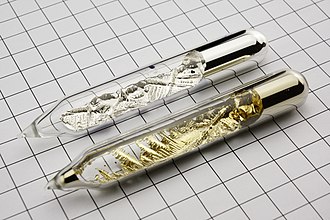Caesium




Caesium (or cesium in American English) is a chemical element with the symbol Cs and atomic number 55. It is a soft, silvery-gold alkali metal with a melting point of 28.5 °C (83.3 °F), which makes it one of only five metallic elements that are liquid at or near room temperature. Caesium is an element in the periodic table that is characterized by its large atomic radius, low ionization energy, and high reactivity, especially in water.
Properties[edit]
Caesium is highly reactive and highly explosive in water. It is the most electropositive and alkaline element. The metal is characterized by a spectrum of yellow lines in its flame test. Caesium metal is soft and easily cut with a knife. The metal's low melting point (slightly above room temperature) means it can melt in one's hand.
Occurrence[edit]
Caesium is not widely distributed in nature, but it is found in minute amounts in mineral water, and more abundantly in pollucite, a rare mineral. The largest deposits of pollucite, which is the primary source of caesium, are found in Zimbabwe, Canada, and Namibia.
Applications[edit]
Caesium has several applications due to its unique properties. It is used in atomic clocks, which are incredibly accurate timekeeping devices. Caesium atomic clocks form the basis for the world's time standard. The element is also used in oil drilling fluids, in electricity generation and transmission, in photoelectric cells, and as a getter in vacuum tubes.
Isotopes[edit]
Caesium has at least 39 known isotopes, ranging from Cs-112 to Cs-151. Caesium-133 is the only stable isotope and thus makes up all natural caesium. The radioactive isotope caesium-137, with a half-life of about 30.17 years, is a significant product of nuclear fission and is one of the more problematic elements in nuclear waste.
Health and Safety[edit]
Caesium is highly reactive and requires careful handling. It reacts explosively with water and can cause burns on contact with skin. Caesium compounds, especially caesium chloride and caesium nitrate, can be hazardous. Caesium-137, being radioactive, poses a significant health risk and is a major concern in the aftermath of nuclear reactor accidents, such as the Chernobyl disaster.
Environmental Impact[edit]
The release of caesium into the environment, primarily caesium-137, can have long-term environmental impacts. It can contaminate soil and water and enter the food chain, posing risks to human health and wildlife. Cleanup and containment of caesium contamination are challenging and costly.
![]()
This chemical element related article is a stub. You can help WikiMD by expanding it.
Ad. Transform your life with W8MD's Budget GLP-1 injections from $75


W8MD offers a medical weight loss program to lose weight in Philadelphia. Our physician-supervised medical weight loss provides:
- Weight loss injections in NYC (generic and brand names):
- Zepbound / Mounjaro, Wegovy / Ozempic, Saxenda
- Most insurances accepted or discounted self-pay rates. We will obtain insurance prior authorizations if needed.
- Generic GLP1 weight loss injections from $75 for the starting dose.
- Also offer prescription weight loss medications including Phentermine, Qsymia, Diethylpropion, Contrave etc.
NYC weight loss doctor appointmentsNYC weight loss doctor appointments
Start your NYC weight loss journey today at our NYC medical weight loss and Philadelphia medical weight loss clinics.
- Call 718-946-5500 to lose weight in NYC or for medical weight loss in Philadelphia 215-676-2334.
- Tags:NYC medical weight loss, Philadelphia lose weight Zepbound NYC, Budget GLP1 weight loss injections, Wegovy Philadelphia, Wegovy NYC, Philadelphia medical weight loss, Brookly weight loss and Wegovy NYC
|
WikiMD's Wellness Encyclopedia |
| Let Food Be Thy Medicine Medicine Thy Food - Hippocrates |
Medical Disclaimer: WikiMD is not a substitute for professional medical advice. The information on WikiMD is provided as an information resource only, may be incorrect, outdated or misleading, and is not to be used or relied on for any diagnostic or treatment purposes. Please consult your health care provider before making any healthcare decisions or for guidance about a specific medical condition. WikiMD expressly disclaims responsibility, and shall have no liability, for any damages, loss, injury, or liability whatsoever suffered as a result of your reliance on the information contained in this site. By visiting this site you agree to the foregoing terms and conditions, which may from time to time be changed or supplemented by WikiMD. If you do not agree to the foregoing terms and conditions, you should not enter or use this site. See full disclaimer.
Credits:Most images are courtesy of Wikimedia commons, and templates, categories Wikipedia, licensed under CC BY SA or similar.
Translate this page: - East Asian
中文,
日本,
한국어,
South Asian
हिन्दी,
தமிழ்,
తెలుగు,
Urdu,
ಕನ್ನಡ,
Southeast Asian
Indonesian,
Vietnamese,
Thai,
မြန်မာဘာသာ,
বাংলা
European
español,
Deutsch,
français,
Greek,
português do Brasil,
polski,
română,
русский,
Nederlands,
norsk,
svenska,
suomi,
Italian
Middle Eastern & African
عربى,
Turkish,
Persian,
Hebrew,
Afrikaans,
isiZulu,
Kiswahili,
Other
Bulgarian,
Hungarian,
Czech,
Swedish,
മലയാളം,
मराठी,
ਪੰਜਾਬੀ,
ગુજરાતી,
Portuguese,
Ukrainian